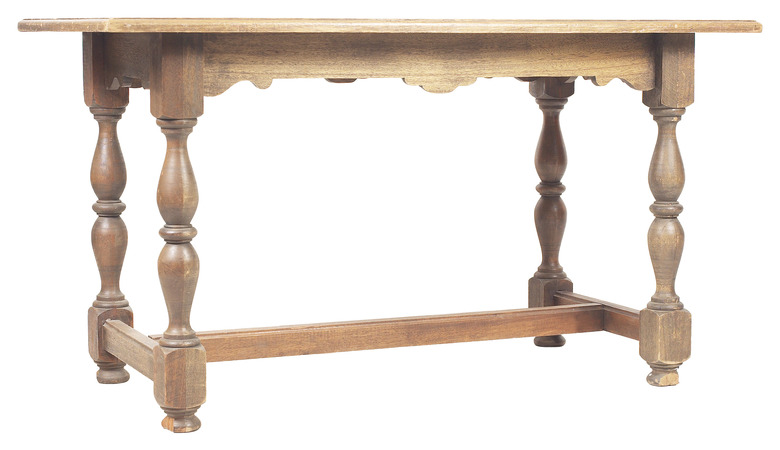How To Stabilize A Lightweight Table
Production tables are built affordable. Manufacturers use single pieces of lightweight particleboard or plywood to reduce building costs, often sacrificing stability in the process. Some manufacturers use spindly legs that loosen. Custom furniture builders know that corner blocks can add years of life to a table. You can beef up almost any table using a few simple methods.
Corner Blocks
Corner Blocks
The best way to stabilize almost any table is to add corner blocks to the legs. Look under almost any custom or expensive table. You'll see angular blocks spanning across the top of leg diagonally from side to side, encasing the leg under the table apron, which is an overhang that goes around the table. If your lightweight table doesn't have them, make your own corner blocks. Start with two pieces of 1 1/4-inch-thick hardwood about 4 inches square. Use a jig saw to cut them diagonally from corner to corner to produce four corner blocks. Cut a notch out of the back of the corner block opposite from the diagonal cut so that the notch fits over the top of the leg and provides additional strength in the corner. Screw the corner block to the sides of the table apron to secure the corner block to the legs and apron. Drive one more screw, centered through the block, into the corner of the table leg.
Ballast
Ballast
Beef up your lightweight table by adding some ballast. This serves to flatten errant, thin tabletops, as well as add some weight to keep them where they belong. Measure the length and width under the table between the legs. Use a table saw to cut a piece of high-density particleboard to the measurements. This type of particleboard is one of the heaviest building materials available. The more density, the heavier it is. It also has a slick, smooth surface that's extremely flat and consistent. If your existing tabletop has seen better days, screw the high-density particleboard directly to the top. If you want to keep the original top, screw the particleboard to the underside of the top.
Leg Overlay
Leg Overlay
Any kind of vertical stabilization to the legs is beneficial. The added support of a simple leg overlay can lengthen the lifespan of the table. Measure the width of the legs and cut 3/4-inch-thick strips of hardwood for each leg. Add one piece for moderate stability or two, three or four pieces to the sides of the leg to really beef up the suspension. Sand and finish them as needed before or after you screw them to the legs. For a designer look, use bullnose or profiled moldings instead of hardwood strips.
Stretchers
Stretchers
Lots of tables have built-in stretchers to add stability. Stretchers are horizontal pieces of hardwood about 4 inches up from the floor. Two stretchers run between the sides of the legs on the table's short ends, with one long stretcher connecting the two short stretchers in the center. This keep the legs from spreading apart and stabilizes the table by joining everything together. Build a stretcher by measuring across the legs on the sides of the table. Cut 1 1/4-inch-square pieces of hardwood to the measurements. Place them between the legs on both sides, and then measure the distance between the two short stretchers and cut a long stretcher to fit between them. Screw or dowel the stretchers together and then screw the assembly between the legs, 4 inches up from the floor to connect and stabilize the legs and table.
